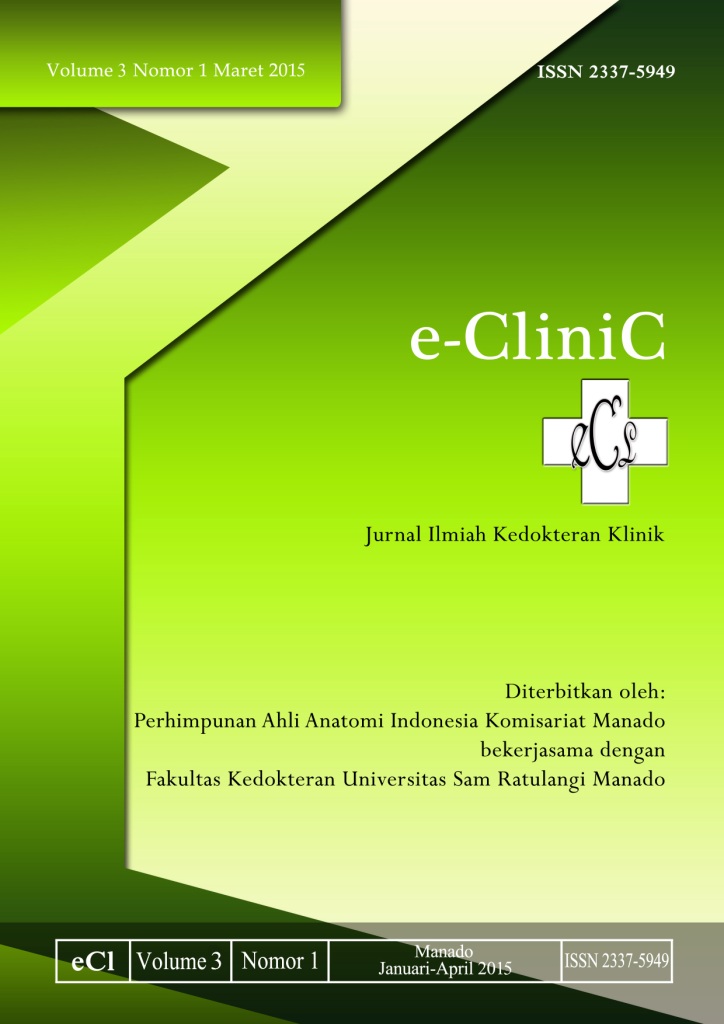HUBUNGAN ANTARA SKOR IPSS DENGAN QUALITY OF LIFE PADA PASIEN BPH DENGAN LUTS YANG BEROBAT DI POLI BEDAH RSUP PROF. DR. R. D. KANDOU MANADO
DOI:
https://doi.org/10.35790/ecl.v3i1.7481Abstract
Abstract: Benign prostatic hyperplasia (BPH) is a disease that is rarely life-threatening, but resulting in annoying complaints and decreasing the quality of life of the patients. BPH is found in older men. BPH patients who come for treatment are usually accompanied with lower urinary tract symptoms (LUTS). BPH patients with LUTS symptoms usually come to the clinic when they feel that the symptoms are bothering their daily-lives, therefore, decreasing the quality of life (QoL). BPH is caused by many factors, as follows: knowledge, economic, social, or cultural factors. To determine the severity of BPH with LUTS, we used the International Prostate Symptom Scoring Score (IPSS) and 1 question about the quality of life. Based on the results of cross-sectional study in December 2014 we obtained 37 patients as samples. Most patients belonged to the age group of 70-79 years (62.2%). The majority of respondents had severe degree of IPSS score (20 patients, 54.1%). The value of QoL scores showed that 10 patients (27%) were not happy with their quality of life. The Spearman correlation test was used to find whether there was a correlation between the IPSS score and Quality of Life (QoL) of BPH patients with LUTS symptoms. There was a significant correlation (p < 0.005) between IPSS-QoL (r = 0.481). The reason that patients with symptoms of BPH LUTS came the surgical clinic of Prof. Dr R. D. Kandou Hospital Manado with severe symptoms and decreases QoL was their lack of knowledge about BPH.
Keywords: BPH, LUTS, IPSS, QoL, Manado
Abstrak: Hiperplasia prostat jinak atau Benign Prostatic Hyperplasia (BPH) merupakan penyakit yangjarang mengancamjiwa tetapi cukup memberikan keluhan yang menjengkelkan dan menurunkan kualitas hidup penderitanya dan sering ditemukan pada pria usia lanjut. Pasien BPH yang datang berobat biasanya disertai dengan LUTS (lower urinary tract symptoms). Pasien BPH dengan gejala LUTS yang mencari pengobatan medis biasanya datang pada saat dirinya merasa bahwa gejala yang dirasakan sudah cukup menggangu aktivitas sehari-hari atau dengan kata lain, mengganggu kualitas hidupnya. Keadaan seperti ini disebabkan oleh banyak faktor, antara lain faktor pengetahuan, ekonomi, atau sosial budaya. Untuk menentukan derajat berat ringannya BPH yang disertai dengan gejala LUTS, digunakan skoring International Prostate Symptom Score (IPSS) dan 1 pertanyaan mengenai kualitas hidup. Berdasarkan hasil penelitian potong lintang yang dilakukan selama bulan Desember 2014 didapatkan 37 sampel. Insiden BPH terbanyak berada pada kisaran umur 70-79 tahun sebanyak 23 pasien (62,2%). Derajat BPH yang paling sering ialah derajat berat sebanyak 20 pasien (54,1%). Nilai skor kualitas hidup yang sering dirasakan pasien menunjukkan bahwa 10 pasien (27%) merasa tidak senang dengan kualitas hidupnya. Hasil uji korelasi antara IPSS-QOL didapatkan bermakna (p<0,005), dengan nilai r = 0,481. Faktor yang menjadi alasan mengapa pasien-pasien BPH dengan gejala LUTS yang berobat di Poli Bedah RSUP Prof. Dr. 490
Mandang, Monoarfa, Salem: Hubungan antara skor...
R. D. Kandou Manado datang dengan gejala yang berat dan kualitas hidup tidak senang ialah kurangnya pengetahuan mengenai BPH itu sendiri.
Kata kunci: BPH, LUTS, IPSS, QOL, Manado
Downloads
How to Cite
Issue
Section
License
COPYRIGHT
Authors who publish with this journal agree to the following terms:
Authors hold their copyright and grant this journal the privilege of first publication, with the work simultaneously licensed under a Creative Commons Attribution License that permits others to impart the work with an acknowledgment of the work's origin and initial publication by this journal.
Authors can enter into separate or additional contractual arrangements for the non-exclusive distribution of the journal's published version of the work (for example, post it to an institutional repository or publish it in a book), with an acknowledgment of its underlying publication in this journal.
Authors are permitted and encouraged to post their work online (for example, in institutional repositories or on their website) as it can lead to productive exchanges, as well as earlier and greater citation of the published work (See The Effect of Open Access).







